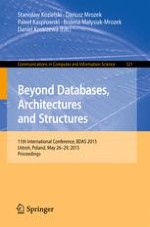2015 | Buch
Beyond Databases, Architectures and Structures
11th International Conference, BDAS 2015, Ustroń, Poland, May 26-29, 2015, Proceedings
herausgegeben von: Stanisław Kozielski, Dariusz Mrozek, Paweł Kasprowski, Bożena Małysiak-Mrozek, Daniel Kostrzewa
Verlag: Springer International Publishing
Buchreihe : Communications in Computer and Information Science
